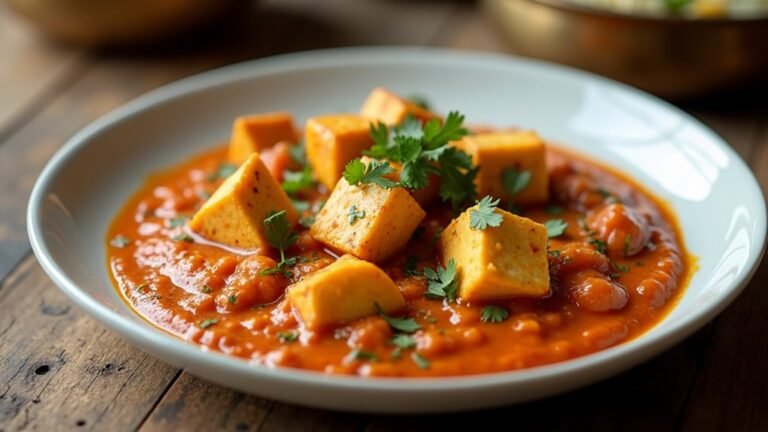Veg Biryani Recipe: Aromatic and Flavorful
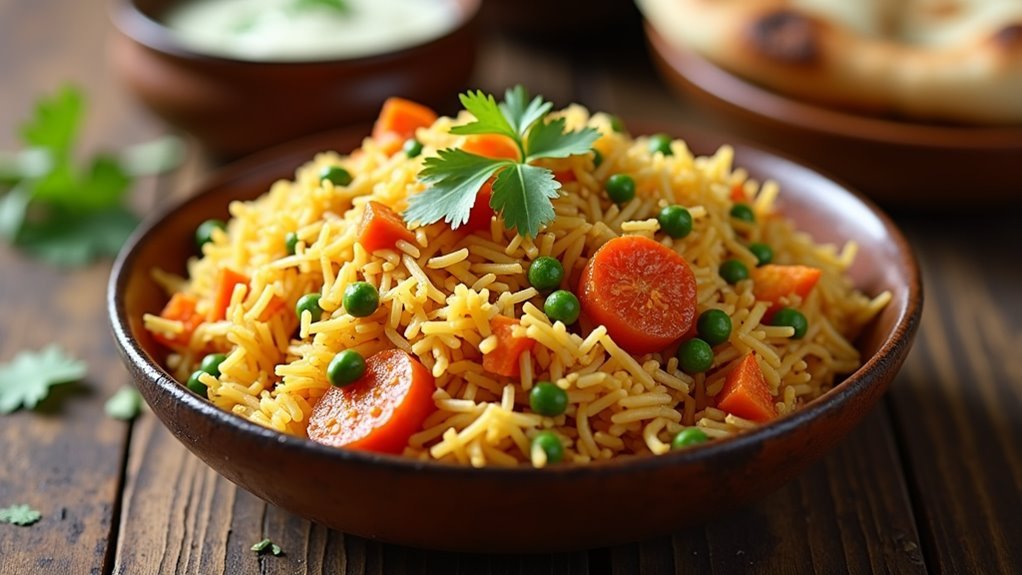
Begin your culinary journey with Veg Biryani, an aromatic and flavorful dish. Imagine perfectly cooked basmati rice combined with vibrant vegetables and a rich blend of spices.
Start by rinsing and soaking the rice to ensure each grain is separate and fluffy. As onions sauté to a golden hue, their sweet aroma hints at the delicious layers to come.
Achieving the perfect spice balance is key. There's a secret technique that elevates this dish from good to unforgettable.
Key Takeaways
- Use basmati rice for its fluffiness and distinct aroma in the biryani.
- Incorporate a mix of colorful vegetables like carrots and peas for nutrition.
- Sauté onions in ghee to enhance sweetness and depth of flavor.
- Add biryani masala powder for a rich and authentic flavor profile.
- Allow biryani to rest post-cooking for improved texture and flavor melding.
Recipe
Vegetable biryani is a delightful Indian dish that showcases a harmonious blend of basmati rice, assorted vegetables, and aromatic spices. With its roots in traditional Indian cuisine, this simplified version allows you to enjoy the authentic flavors without the complexity of a lengthy ingredient list or intricate cooking techniques. Perfect as a standalone meal or a side dish, vegetable biryani offers a satisfying and memorable dining experience.
By using just five essential ingredients, this recipe makes it easy for home cooks to recreate the classic taste of biryani. The fragrance of basmati rice combined with the richness of ghee and the warmth of biryani masala powder envelops the vegetables, transforming them into a vibrant and flavorful dish. Follow these simple steps to bring the beloved taste of vegetable biryani to your kitchen.
Ingredients:
- Basmati rice (2 cups)
- Mixed vegetables (2 cups – carrots, peas, potatoes)
- Biryani masala powder (2 tablespoons)
- Ghee or vegetable oil (1/4 cup)
- Onions (2 medium-sized)
To start, rinse the basmati rice thoroughly and soak it in water for 30 minutes. While the rice is soaking, heat the ghee or vegetable oil in a large pot over medium heat.
Add the sliced onions and sauté them until they turn golden brown. Next, add the mixed vegetables and biryani masala powder, stirring well to ensure the vegetables are evenly coated with the spices.
Drain the soaked rice and add it to the pot along with 4 cups of water. Bring the mixture to a boil, then reduce the heat to low, cover the pot, and let it simmer for 15-20 minutes or until the rice is fully cooked and has absorbed all the water.
For the best results, allow the biryani to rest for 10 minutes after cooking before fluffing it gently with a fork. If the rice appears too dry during cooking, add a little hot water incrementally to maintain moisture.
Ensure the vegetables are cut into uniform sizes to promote even cooking throughout the dish. Leftovers can be stored in an airtight container in the refrigerator for up to three days; when reheating, add a sprinkle of water to help retain the moisture and fluffiness of the rice.
Cooking Steps
Let's embark on the flavorful journey of making veg biryani by starting with a crucial step: rinse and soak your basmati rice to ensure it cooks perfectly fluffy.
While the rice is soaking, heat some ghee and sauté onions until they're beautifully golden, enhancing the dish's aroma.
Next, coat your mixed vegetables with biryani masala, add the rice and water, then let it all simmer gently until the rice is perfectly cooked and infused with delightful spices.
Step 1. Rinse and Soak Rice
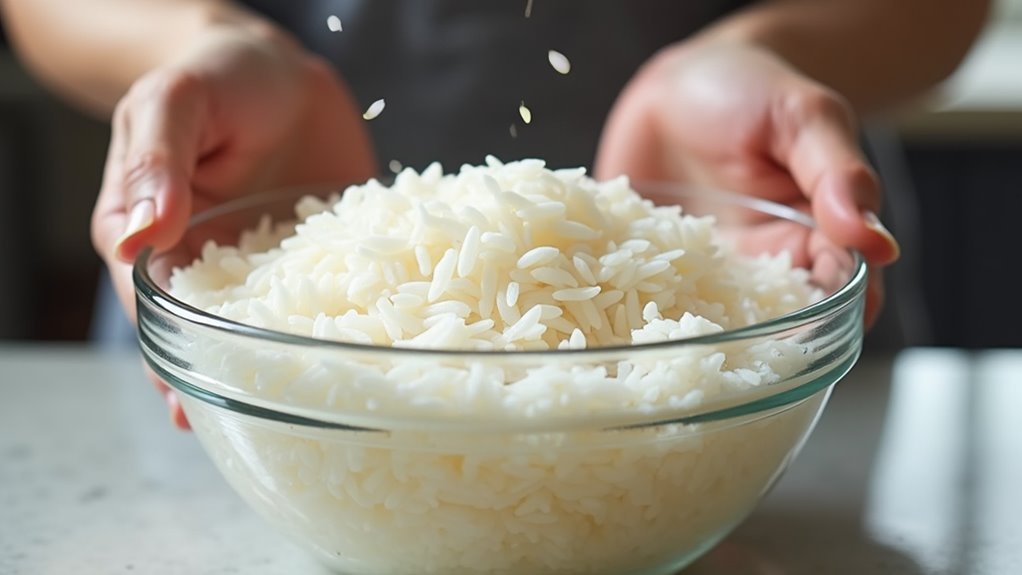
Starting with well-prepared rice is crucial for a successful vegetable biryani. First, grab your basmati rice, which is essential for that fluffy, aromatic finish.
Rinse the rice under cold water, gently swirling it around to remove excess starch. You'll notice the water turning milky at first, but keep rinsing until it runs clear. This step is key to ensuring your biryani doesn't turn into a sticky mess.
Once rinsed, soak the rice for about 30 minutes. Soaking allows the grains to absorb some moisture, shortening the cooking time and giving each grain a lovely, tender texture.
While your rice is soaking, you can start preparing the other ingredients, setting the stage for a delightful cooking experience. Enjoy the process!
Step 2. Sauté Onions Until Golden
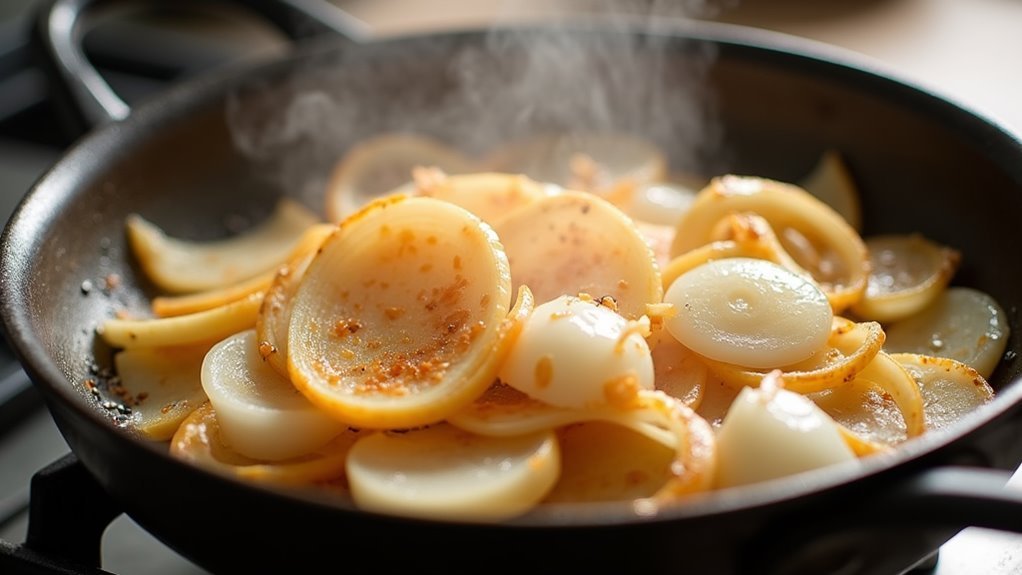
To achieve that rich and deep flavor in your biryani, you'll want to sauté the onions until they're golden brown.
Start by heating ghee or vegetable oil in a large pot over medium heat. Once the oil shimmers, add your sliced onions. Stir them gently, ensuring they're evenly coated with the oil.
Watch as they transform from pale slices to deliciously golden strands, releasing a sweet, enticing aroma that fills your kitchen. This process might take 10-15 minutes, so be patient.
Stir frequently to prevent burning and ensure even cooking. The golden onions will add a delightful sweetness and depth to your biryani, making each bite irresistible.
Your kitchen will smell amazing, inviting everyone to gather around.
Step 3. Coat Vegetables With Masala
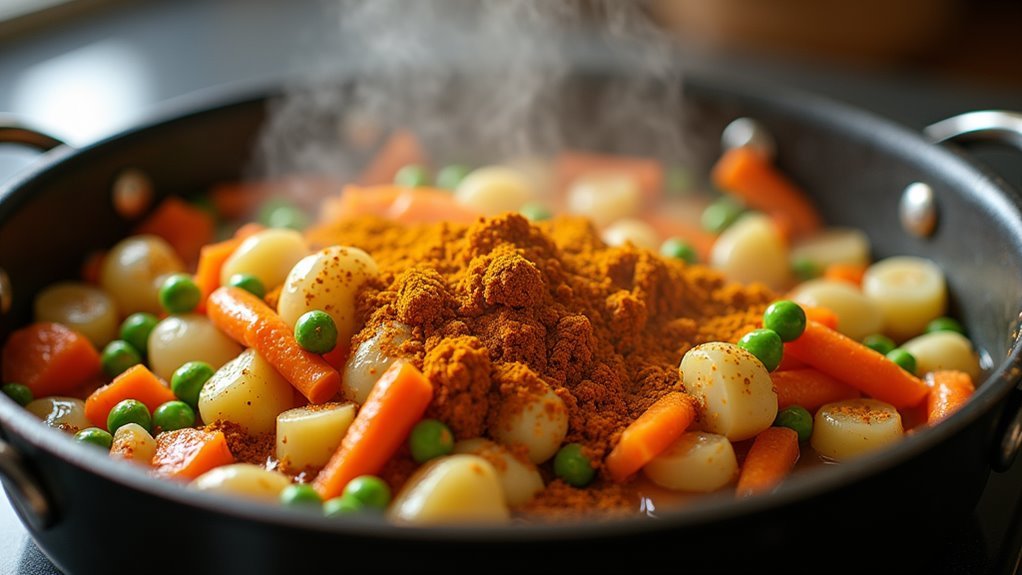
A burst of flavor awaits as you coat the vegetables with masala.
With the onions now a perfect golden brown, it's time to introduce your mixed vegetables to the pot. Add in the vibrant carrots, peas, and potatoes, feeling the warmth of the ghee envelop them.
Sprinkle the biryani masala powder over the vegetables, breathing in the rich and tantalizing aroma. Stir everything together, ensuring each piece is well-coated, embracing the spices with enthusiasm.
This step is crucial, as it infuses the vegetables with the essence of the dish, promising a mouthful of delight with every bite.
Take a moment to appreciate how the masala enhances the colors and fragrances, making this biryani truly unforgettable.
Step 4. Add Rice and Water
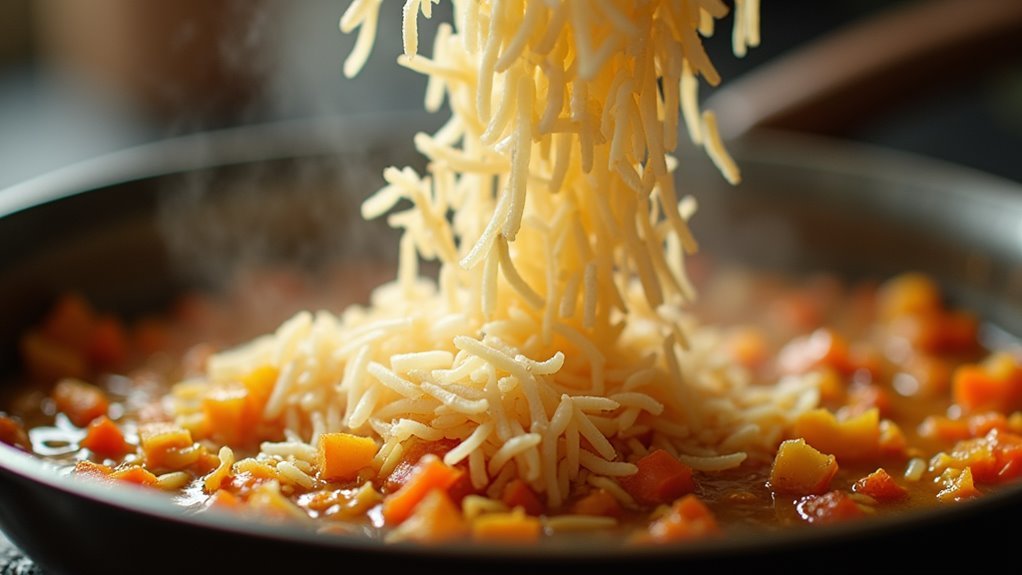
With the vegetables beautifully coated in masala, it's time to introduce the basmati rice to the pot.
You've already rinsed and soaked it, ensuring each grain is ready to soak up the flavors. Drain the rice thoroughly, then gently add it to the vibrant mix of vegetables and spices.
Watch as the rice starts to mingle with the masala, promising a symphony of taste.
Next, pour in 4 cups of water, enough to cook the rice and bring out its fluffy perfection.
Stir gently to combine, ensuring the rice is evenly distributed throughout the pot.
Feel the anticipation build as you bring the mixture to a boil, seeing the steam rise.
This is where the magic really begins!
Step 5. Simmer Rice Until Cooked
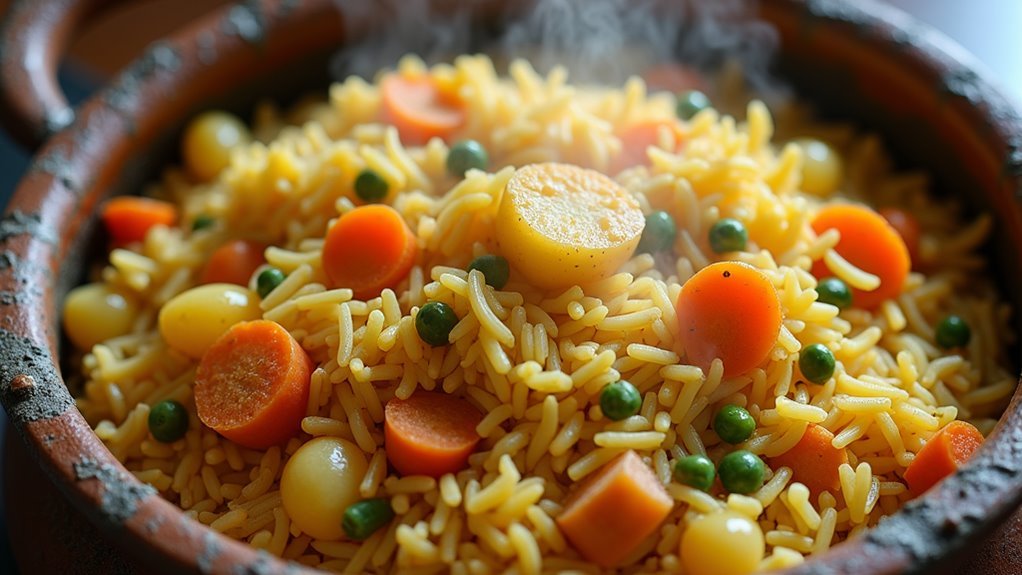
Now it's time to let the biryani work its magic. Once you've added the rice and water to the pot, bring it to a boil.
This is where patience pays off. Lower the heat to a gentle simmer, cover the pot with a lid, and let the flavors meld beautifully.
You'll want to keep an eye on it, but resist the urge to lift the lid too often. Trust the process as the rice absorbs all those wonderful flavors, becoming tender and aromatic.
After about 15-20 minutes, check if the rice is cooked to perfection. It should be fluffy and have absorbed all the water.
Final Thoughts
Creating a delicious vegetable biryani at home doesn't have to be daunting. With this simplified recipe, you'll experience the satisfaction of crafting a flavorful, aromatic dish right in your kitchen.
The blend of spices and fresh vegetables transforms every bite into a delightful experience that'll impress your family and guests. Don't worry about mastering complex techniques; this recipe is designed to be approachable yet authentic.
As you perfect your biryani, remember that practice makes perfect. Feel free to adjust spices to match your taste preference, ensuring every plate is uniquely yours.
Embrace the joy of cooking and the vibrant colors and flavors that this dish offers. Soon, you'll find yourself craving this homemade masterpiece again and again, relishing in the culinary adventure.
Frequently Asked Questions
Can I Use Brown Rice Instead of Basmati?
You can absolutely use brown rice instead of basmati for your biryani.
Brown rice adds a nutty flavor and is a healthier option. Just keep in mind, it requires a bit more time to cook, so you'll need to adjust your cooking time accordingly.
Use slightly more water, and let it simmer until the rice is tender.
You'll love the wholesome twist it brings to this aromatic dish! Enjoy experimenting!
What Vegetables Can Be Included Besides Carrots, Peas, and Potatoes?
Get creative with your veggie choices! You can add bell peppers, beans, baby corn, or broccoli to boost the biryani's burst of flavors.
Cauliflower, zucchini, and spinach also make splendid additions, adding both color and crunch.
These veggies not only enhance the dish's nutritional value but also its visual appeal.
Don't hesitate to experiment with your favorites, creating a tasty tapestry of textures that tempts the taste buds, making each bite delightful.
Is It Possible to Make This Dish Vegan?
Absolutely, you can make this dish vegan! Just swap out the ghee for vegetable oil or any plant-based butter.
The rest of the ingredients are already vegan-friendly, making it easy to adapt. You'll still enjoy the same rich flavors and aromatic spices.
Cooking vegan doesn't mean sacrificing taste, and this dish proves it. Dive into this delightful meal, and you'll see how satisfying vegan cooking can be!
Enjoy the journey!
How Can I Make the Biryani Spicier?
To make your biryani spicier, add more biryani masala powder or toss in a few chopped green chilies for an extra kick.
You can also include a pinch of red chili powder or cayenne pepper.
Remember to taste as you go, so it doesn't become too fiery.
These additions will elevate the heat while maintaining that delicious balance of flavors.
Get ready to enjoy a spicy, mouthwatering experience!
Can I Prepare Biryani in an Instant Pot?
Absolutely, you can prepare biryani in an Instant Pot, and it's a game-changer!
Start by using the sauté function to brown onions in ghee or oil. Add your mixed vegetables and biryani masala, stirring well.
Then, mix in rinsed basmati rice and water. Use the rice setting or manual pressure cook for about 6 minutes, followed by a quick release.
It's fast, flavorful, and keeps all the aromatic goodness intact!

